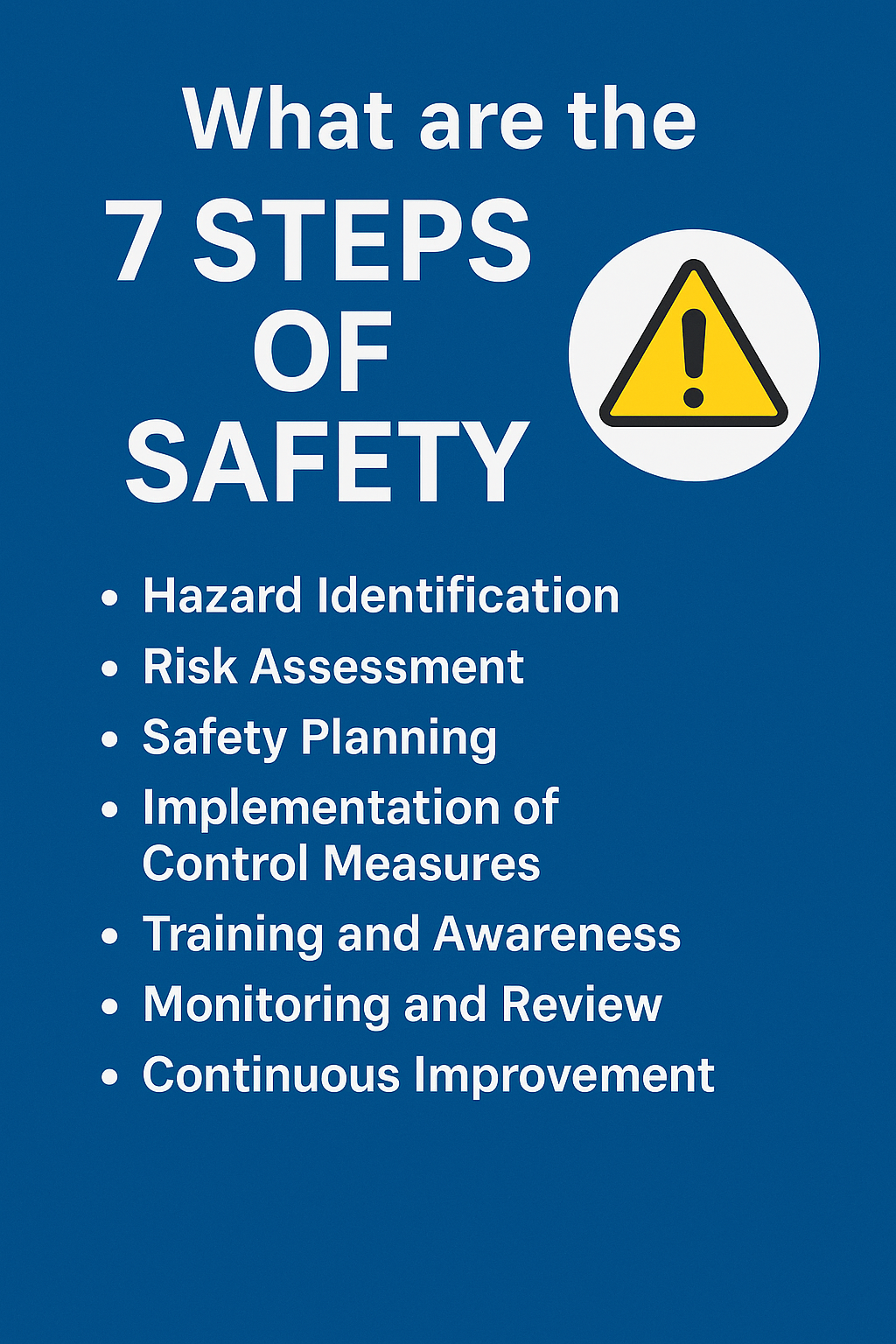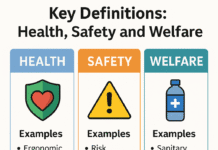
What are the 7 Steps of Safety?
Safety isn’t just about wearing a helmet or following a checklist—it’s about building a culture where risks are recognized, managed, and reduced. Whether you’re at home, in the workplace, or out in public, safety measures keep people healthy, protect property, and ensure smooth operations. But how do you achieve safety in a structured way?
That’s where the 7 steps of safety come in. Think of them as a roadmap—each step builds on the previous one, creating a strong foundation for a safe environment. Let’s dive deep into each step and see how they work.
Step 1: Hazard Identification
The first step to safety is spotting the danger. A hazard is anything with the potential to cause harm.
Types of Hazards
- Physical Hazards – noise, heat, electricity, machinery
- Chemical Hazards – toxic gases, flammable liquids, dusts
- Biological Hazards – bacteria, viruses, molds
- Ergonomic Hazards – poor workstation design, repetitive tasks
- Psychosocial Hazards – stress, bullying, long working hours
How to Identify Hazards
- Regular workplace inspections
- Safety observation tours
- Employee feedback and incident reporting
- Job Safety Analysis (JSA) and HIRA (Hazard Identification & Risk Assessment)
👉 Without hazard identification, the rest of the steps are blind guesses.
Step 2: Risk Assessment
Once hazards are identified, the next step is assessing how dangerous they are.
Hazard vs. Risk
- Hazard = source of potential harm (e.g., fire)
- Risk = likelihood and severity of harm (e.g., fire burns causing injuries)
Risk Assessment Methods
- Qualitative – Low/Medium/High rating
- Quantitative – Numerical scores and probabilities
- Risk Matrix – Combines likelihood and severity to prioritize hazards
Example:
- Slippery floor = Hazard
- Risk = High (likely to happen, may cause serious injury)
Step 3: Safety Planning
After risks are evaluated, organizations must plan how to control them.
Elements of Safety Planning
- Written safety policy
- Defined roles and responsibilities
- Emergency response procedures
- Resource allocation (budget, equipment, manpower)
Planning ensures safety isn’t left to chance but is part of daily operations.
Step 4: Implementation of Control Measures
This is where action happens. Safety measures are applied to control risks.
Hierarchy of Controls
- Elimination – Remove the hazard completely (e.g., ban hazardous chemicals).
- Substitution – Replace with a safer alternative (e.g., water-based paints instead of solvent-based).
- Engineering Controls – Physical changes (e.g., machine guards, ventilation).
- Administrative Controls – Rules and training (e.g., shift rotation, SOPs).
- PPE (Personal Protective Equipment) – Helmets, gloves, masks, safety shoes.
👉 PPE is the last line of defense, not the first.
Step 5: Training and Awareness
Even the best controls fail if people don’t know how to use them.
Training Tools
- Toolbox talks
- E-learning modules
- Safety drills (fire, evacuation)
- Posters, signage, and reminders
Why Training Matters
- Creates a safety culture
- Empowers employees to report hazards
- Ensures consistent safe practices
Step 6: Monitoring and Review
Safety isn’t a one-time job—it needs constant tracking.
How to Monitor Safety
- Regular safety audits
- Near-miss reporting systems
- Workplace walkthroughs
- Safety KPIs (incident rate, lost-time injuries, audit scores)
Review Process
- Identify trends from past incidents
- Take corrective actions
- Evaluate effectiveness of control measures
Step 7: Continuous Improvement
Safety is a cycle, not a destination.
Methods of Improvement
- PDCA Cycle – Plan → Do → Check → Act
- Learn from accidents and near-misses
- Encourage innovation (apps, sensors, automation)
- Benchmarking against industry best practices
👉 The goal is not just to reduce accidents but to eliminate them.
Benefits of Following the 7 Steps
- Fewer workplace accidents and injuries
- Improved compliance with safety laws
- Increased productivity and employee morale
- Reduced insurance and compensation costs
Common Mistakes Organizations Make
- Treating safety as paperwork, not culture
- Ignoring employee feedback
- Relying only on PPE without eliminating hazards
- Lack of leadership involvement
Case Study: Manufacturing Plant
A factory introduced the 7 steps of safety after facing repeated accidents. Within 12 months:
- Accidents reduced by 60%
- Employee satisfaction improved
- Insurance premiums dropped significantly
Safety in Different Industries
- Construction – Focus on fall protection, scaffolding, machinery safety
- Oil & Gas – Hazardous chemicals, fire safety, confined spaces
- Healthcare – Infection control, ergonomic safety for staff
- Offices – Ergonomics, stress management, electrical safety
How Employees Can Contribute
- Report unsafe acts immediately
- Follow procedures and wear PPE
- Participate actively in training
- Encourage peers to follow safety practices
Conclusion
Safety is not about luck—it’s about preparation. By following the 7 steps of safety—Hazard Identification, Risk Assessment, Safety Planning, Implementation, Training, Monitoring, and Continuous Improvement—you create a sustainable safety culture.
Whether you’re a worker, manager, or employer, these steps can transform your workplace into a safer, healthier environment. Remember, safety is everyone’s responsibility.
Static Electricity Hazards in the Workplace
How to Conduct a Fire Drill: Step-by-Step Safety Officer Guide
Key Definitions: Health, Safety and Welfare with Examples
Oil and Gas Safety Training Courses: Boost Your Career with the Right Training
FAQs
1. What is the first step in safety?
The first step is Hazard Identification—spotting anything that could cause harm.
2. Why is training critical in safety management?
Because even the best safety plans fail if people don’t know how to apply them. Training builds awareness and consistent practices.
3. Can small businesses implement the 7 steps?
Yes, these steps can be scaled down to suit any workplace size.
4. How do safety audits support continuous improvement?
Audits highlight gaps in the system, allowing corrective and preventive measures to be taken.
5. What role does technology play in modern safety systems?
Technology helps in early hazard detection, real-time monitoring, and predictive analytics to prevent accidents.
























